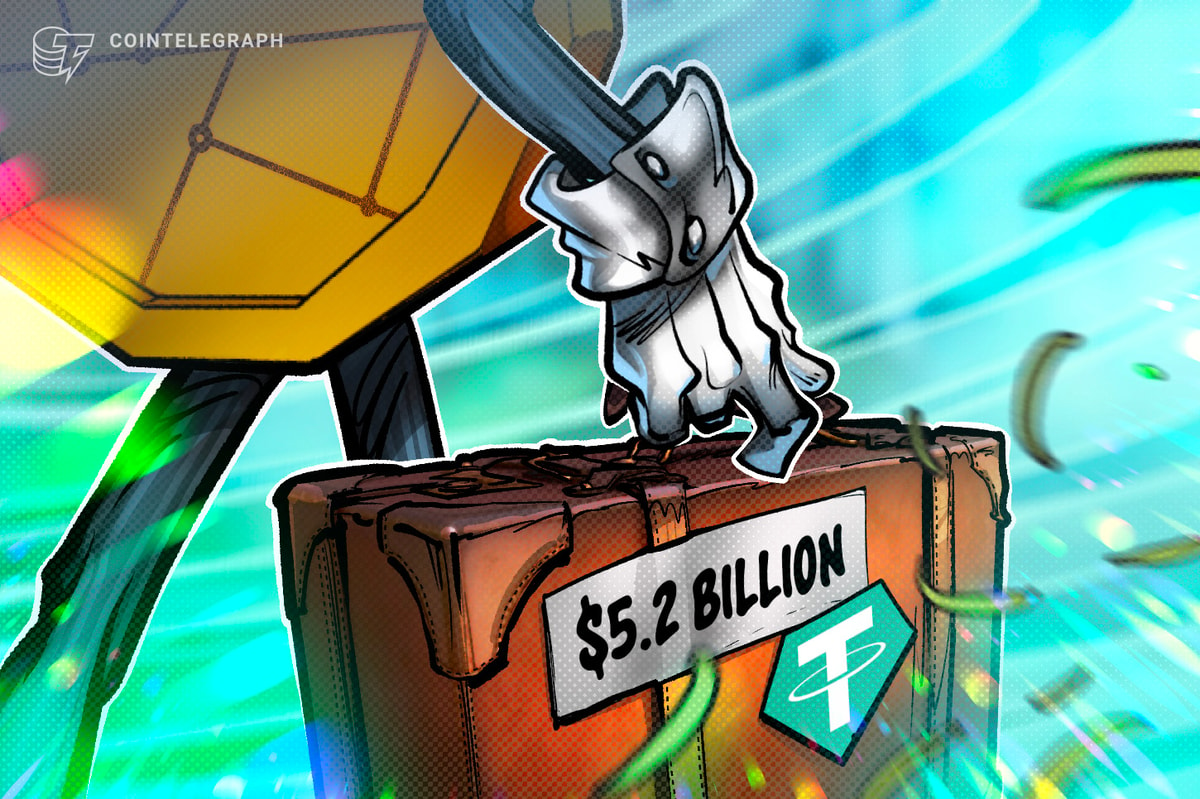USDT profitability — Tether profit 2024
In the first half of 2024, Tether quietly posted one of the biggest profit hauls in crypto history, pulling in a staggering $5.2 billion across just two quarters.
That’s not a typo: $4.52 billion in Q1, followed by another $1.3 billion in Q2.
Contrary to popular belief, this windfall didn’t come from trading fees or printing more USDt (USDT). It came almost entirely from interest income on Tether’s reserve assets — mainly US Treasuries.
By mid-2024, Tether had accumulated $97.6 billion worth of US government debt, quietly becoming one of the world’s largest holders of Treasurys, outpacing the reserves of many sovereign nations.
This all reveals a key part of the stablecoin business model: Users deposit fiat (like USD), and in return, Tether mints USDT while investing those dollars into low-risk, yield-generating assets.
So, if you’ve ever wondered how stablecoins make money, this is it: Fiat-backed stablecoins like Tether’s USDT act as financial intermediaries. With global interest rates still elevated, that passive income engine is now more powerful than ever.
Did you know? The world’s first stablecoin was BitUSD, launched in July 2014. Created by blockchain pioneers Charles Hoskinson and Dan Larimer on the BitShares platform, BitUSD attempted to maintain its peg by locking BTS tokens into smart contracts as collateral.
How Tether makes money
Stablecoin issuers don’t lend money like traditional banks, but they often earn just as much.
As of March 2025, Tether’s total exposure to US Treasurys — spanning direct holdings, reverse repos and money market funds — approached $120 billion. That makes it one of the top 20 Treasury holders worldwide, with exposure larger than many governments.
But Treasurys are just one piece of the puzzle. Tether’s diversified reserve strategy includes gold, Bitcoin (BTC) and secured loans, offering both yield and protection against volatility. In Q1 2025, for example, gold positions helped buffer swings in crypto markets, showcasing how crypto pegging mechanisms can rely on a mix of hard assets, not just dollars.
Meanwhile, Tether’s ongoing issuance of collateralized loans (backed by its reserves) adds another revenue layer. Though less publicized, these loans have historically brought in hundreds of millions annually.
With $5.6 billion in excess reserves as of March 2025, Tether operates more like a conservative asset manager than a tech startup. Its stablecoin income sources range from interest on Treasurys and precious metals to digital assets and lending, proving that the USDT profitability model is built on more than just crypto hype.
Did you know? Tether was founded in 2014 in Santa Monica, California by Brock Pierce, Reeve Collins and Craig Sellars. Initially called “Realcoin” and built on Bitcoin’s Omni Layer, it rebranded to “Tether” on Nov. 20, 2014.
Tether’s hidden revenue engines: Fees, lending and fintech
Interest income may drive Tether’s core returns, but it’s not the only revenue stream. Here’s a deeper look at how Tether makes money beyond just yield.
1. Transaction and conversion fees
While transferring USDT may feel free for most users, Tether monetizes on the back end, especially from issuance and redemption fees for institutional clients and exchange partnerships.
In early 2025, Tether was raking in over $122 million per week in fees across networks like Ethereum, Tron and Solana, according to DefiLlama and CryptoRank. That adds up to more than $6.4 billion annually, solidifying Tether’s position not only as the top stablecoin by market cap but also as one of the most profitable crypto companies, period.
2. Secured lending
Even after scaling back its lending operations, Tether continues to issue collateralized loans, backed by its reserves. These typically yield more than government bonds and offer high-margin, low-risk income, contributing significantly to Tether’s bottom line, even if exact figures remain undisclosed.
3. Fintech integrations and partnerships
Tether also benefits from its growing ecosystem, integrating with wallets, fintech platforms and exchanges. These integrations (with players like PayPal and Fiserv) open up new channels for revenue through API access, transaction fees and broader network usage.
Why Tether earned so much in 2024
Tether’s 2024 profits surged thanks to high interest rates, massive reserve scale and the flexibility to move faster than traditional financial institutions.
1. A perfect interest-rate environment
Throughout 2024, the US Federal Reserve held rates at elevated levels, which directly boosted yields on US Treasurys, Tether’s single largest revenue driver. With tens of billions parked in these government bonds, Tether’s returns ballooned. This is the core of the stablecoin revenue model: hold user deposits in yield-bearing, fiat-backed assets and pocket the interest.
2. Unmatched scale
By mid-2024, Tether had amassed $118 billion in total reserves — more than enough to back every USDT in circulation. Even small changes in interest rates translated to hundreds of millions in additional profit. This kind of scale is a major reason why Tether’s profit in 2024 dwarfed that of every other stablecoin issuer.
3. Operational flexibility
Unlike regulated banks, Tether isn’t bogged down by capital requirements or complex compliance layers. Its centralized structure lets it move fast, reallocating capital to chase yield, optimizing reserve duration and reacting to market conditions without red tape.
Put together, these three levers — high yields, massive scale and fast execution — made 2024 a perfect storm of stablecoin profitability.
Risks and criticisms of the stablecoin business model
But while the stablecoin business model can be incredibly lucrative, it’s not without controversy, and Tether remains at the center of several debates.
Ongoing regulatory pressure
Tether’s reserve practices and Anti-Money Laundering (AML) compliance have long drawn scrutiny from regulators like the Securities and Exchange Commission and international financial watchdogs. While Tether now publishes regular attestations and has hired seasoned financial leaders, it still hasn’t released a full, independent audit. That leaves the question of whether every USDT is truly backed open to interpretation.
European delistings
Since early 2025, major EU-regulated platforms, including Binance, Kraken and Coinbase, have either delisted USDT or limited it to “sell only” status, citing non-compliance with Markets in Crypto-Assets (MiCA), Europe’s new crypto regulatory framework.

Interest-rate risk
Tether’s profit engine is built on interest income from Treasurys. However, that same strength is a vulnerability. If the Fed cuts rates by even 50 basis points, annual revenue could drop by over $600 million, forcing Tether to chase yield elsewhere or accept tighter margins.
Asset concentration risk
Though Treasurys provide stability, they also create concentration risk. As Tether shifts more into gold, crypto and secured loans, it exposes itself to market volatility and counterparty risk. That’s a trade-off between stability and yield, and one that may become more pronounced as interest rates fall.
Did you know? Under the EU’s MiCA rules, “significant” stablecoins like USDT must hold at least 60% of reserves in European banks — a requirement Tether has refused.
Stablecoin profits, explained: Tether vs. other stablecoin issuers
The basic blueprint for how stablecoins make money is similar across the board: mint tokens, hold fiat reserves and earn interest. But Tether’s dominance makes all the difference.
As of June 2025:
That scale alone gives Tether a massive profitability edge. In 2024, it reported nearly $13 billion in gross profit. By contrast, Circle — despite its strong compliance and institutional focus — earned just $156 million in net income.
Why the gap? Circle splits its interest income with Coinbase, holds reserves in US banks and gets audited monthly by a Big Four firm (Deloitte and Touche). It’s a transparent, conservative model that appeals to institutions but limits revenue.
Paxos follows a similar path: smaller footprint, tight regulation, limited upside. Meanwhile, Tether keeps most of its earnings, plays the volume game and operates with far fewer constraints.
This contrast lays bare the tension between transparency and profit in the crypto revenue models landscape.
With regulations slowly catching up to Tether, it will eventually have to choose between sustaining its sky-high profits in an increasingly limited market or adapting to the stricter rules that now govern its rivals.








